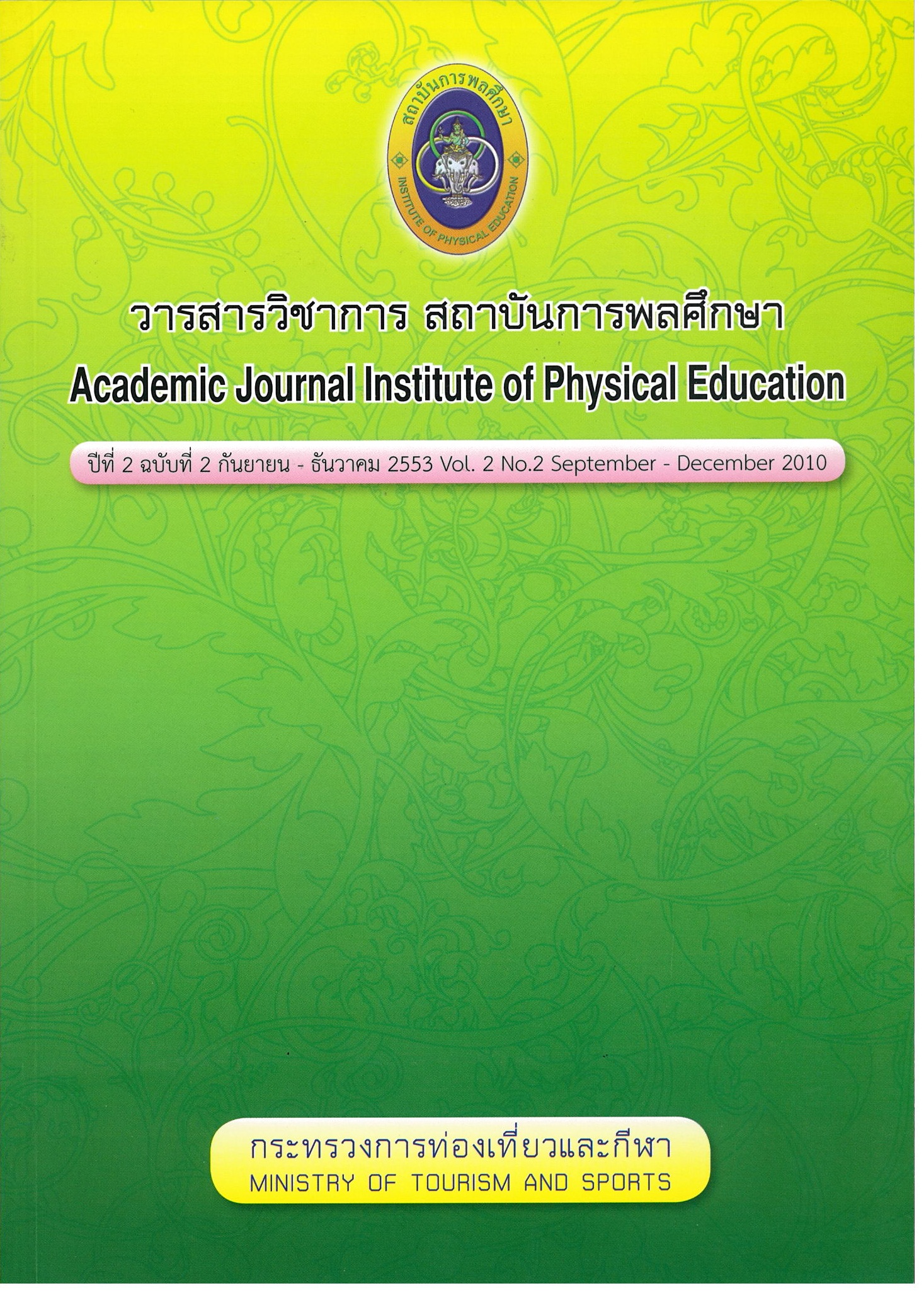The Trend of Pre - Service Physical Education Teacher In the Period of Fifteen Years (2008 - 2022)
Main Article Content
Abstract
The objectives of the study were to analyze the production of the first degree level physical education teachers by teacher institutions starting from the period of the Third National Education Development Plan (1972 - 1976) till that of the Ninth Plan (2002 - 2006), and to synthesize trends of pre – service physical education teacher in the period of fifteen years.
Descriptive research was used in this study. The population under study were 194 pieces of related documents on the production of the physical education teachers from the period of the Third National Educational Development Plan ( 1972 - 1976 ) till that of the Ninth Plan (2002 - 2006), and four groups of experts related to the production and development of the physical education teachers, altogether 65 persons. The research instruments were open – end questionnaires inquiring opinions of experts in teacher production about the draft trends of pre - service physical education teacher production in the next fifteen years and data recording sheets. Tools for analyzing the collected information included a content analysis technique, and percentage.
Results of the study revealed that physical education production during the periods of the Third to the Ninth Plans was based on the philosophy orientating towards output and process rather than giving due importance to recruiting the able and moral students into the teaching profession. There were a lot of teacher institutions in both Ministry of Education and Ministry of Tourism and Sports but it was no unity of the production trend. Therefore, the physical education teacher institutions produced so overload students that they could have no work as teachers in four years ago. In addition, teachers' knowledge and teaching techniques were rate low.
Further, it was found that the production trend in fifteen years was as follow:
1) Factors of physical education teacher production were based on philosophy which focus on input, process, and quality of graduates. With regard to the policy should reform physical education curriculum, improve the quality of the faculty members, and recruit the able students in sports into the teaching profession.
2) Process of physical education teacher production were suggested that determining of curriculum should be geared toward the 5-year study in which students took major-minor, provide more 3 courses such as Thai language for teacher, English for communication for teacher and Leadership, emphasize the students be knowledgeable on academic both health and physical education courses, have the tendency to produce fewer teachers in physical education, and set up the committees at the national levels to ensure the plans and action taken not only demonstrate national needs but respond to regional and international calls for quality.
3) Quality of graduates should have a good understanding of the physical education content, have variety techniques in teaching, be skillful in Thai and international sports, have a good attitude toward their work, be able to manage physical education activities for the disable, communicate at least 2 languages effectively, apply educational technology in physical education activities, and be able to construct school-based curriculum according to educational reform.
Article Details
The published article is a copyright of the Academic Journal of Thailand National Sports University. The passage appeared in each article in this academic journal is a perspective of each author which is not related to the journal. Each author is required to be responsible for all components of his/her own article. If there are any mistakes, each author must be responsible for those mistakes on his/her own.
References
กัญญาพัฒน์ นนทะนาคร. 2539. ผลกระทบของเกณฑ์มาตรฐานวิชาชีพครูที่มีต่อการปฏิรูปการเรียนการสอนในสถาบัน ฝึกหัดครูใน พ.ศ. 2553. วิทยานิพนธ์ปริญญาโท, จุฬาลงกรณ์มหาวิทยาลัย.
เกื้อ วงศ์บุญสิน และสุวาณี สุรเสียงสังข์. 2547. ทักษะแรงงานไทยใน อนาคตที่พึงประสงค์, กรุงเทพมหานคร: โรงพิมพ์แห่งจุฬาลงกรณ์มหาวิทยาลัย.
ฉลอง บุญญานันต์ และคณะ. 2530. สถานภาพและบทบาทในอนาคตของสถาบันฝึกหัดครูในการพัฒนาการศึกษาและพัฒนาประเทศ. ม.ป.ท.
ดวงจันทร์ เดี่ยววิไล. 2532. การวิเคราะห์ หลักสูตรครุศึกษาไทย พ.ศ.2435-2530 . กรุงเทพมหานคร: วิทยานิพนธ์ปริญญาเอก, จุฬาลงกรณ์มหาวิทยาลัย.
ทบวงมหาวิทยาลัย. 2539. แผนพัฒนาการศึกษาระดับอุดมศึกษา ฉบับที่ 8 (พ.ศ. 2540-2544). กรุงเทพมหานคร: เนติกุลการพิมพ์.
ทบวงมหาวิทยาลัย. 2545. รายงานการศึกษา สถาบันอุดมศึกษาของรัฐในสังกัดทบวงมหาวิทยาลัย ปีการศึกษา 2544. กรุงเทพมหานคร:โรงพิมพ์ แห่งจุฬาลงกรณ์มหาวิทยาลัย.
ปนัดดา เจียรกุล. 2541. แนวโน้มหลักสูตรวิชาศึกษาทั่วไปของสถาบันอุดมศึกษาสังกัดทบวงมหาวิทยาลัยในทศวรรษ, กรุงเทพมหานคร: วิทยานิพนธ์ปริญญาโท, จุฬาลงกรณ์มหาวิทยาลัย.
วรศักดิ์ เพียรชอบ. การพัฒนาการการฝึกหัดครูพลศึกษาของไทย, http://www.thaiphysicaleducation.com/modules.php?name=Journal&file=display&id=12 มิถุนายน 2551.
สมหวัง พิธิยานุวัฒน์. 2543. ข้อเสนอแนะเชิงนโยบาย: การปฏิรูปวิชาชีพครูตามพระราชบัญญัติการศึกษาแห่งชาติ, กรุงเทพมหานคร: วัฒนาพานิช.
Fraenkel, Jack R. and Wallen, Norman E. 2003. How to Design and Evaluate Research in Education. 5th ed. New York: McGraw-Hill.
Fuller F. Fuller. 1969. Concern of Teachers: A Developmental Conceptualization. American Educational Research Journal, 6, 207-226.
Interstate New Teacher Assessment and Support Consortium (INTASC). 2002. Standards for Preservice Teachers (Online). Available: http://ifolios.coe.tamu.edu/-ehines/intasc.html
McGee, Clive and Fraser, Deborah. 2001. The Professional Practice of Teaching. Palmerston North: Dunmore Press.
Thomas, Elwyn. 1997 “Models of Teacher Education and their Role in Educational Planning” in Lynch. James. ed. Education and Development: Tradition and Innovation. Vol. 3, London: Cassell Wellington House.

